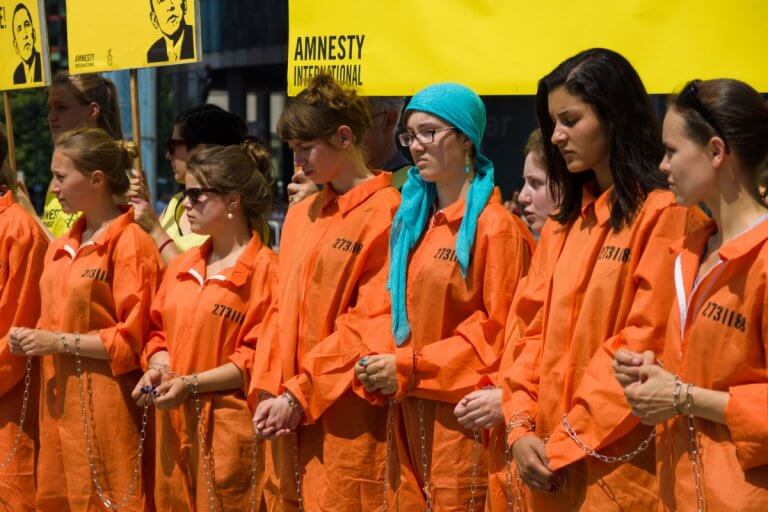
With the growing teacher crisis, Trump’s war on student visas and the college admissions scandal still hitting headlines around the globe, it seems that chaos has disrupted the American education dream.
Experts are closely observing the nation’s academic decline, calling for major reform if the country ever hopes to raise another competitive generation.
But this is likely to require a monumental shift in the nation’s public spending structure, since the US currently spends more on prisons than it does its public schools, with 15 US states spending US$27,000 more per prisoner than they do per student.
While Americans make up just 4.4 percent of the global population, the country is home to almost 25 percent of the world’s imprisoned offenders.
According to an analysis by personal banking site GoBankingRates, California injects US$8.6 billion a year on its prisons, averaging at US$64,642 per inmate. This compares to US$11,495 each Californian student receives, maintaining a huge US$53,147 gap between prison and education spending – the biggest of any US state.
New York comes in with the second-biggest gap, paying US$22,366 per student compared to US$69,355 per inmate.
Connecticut is third with a US$43,201 spending gap between the two, followed by New Jersey in fourth and Rhode Island in fifth, with gaps of US$43,201 and US$43,032 respectively.
Click on the states below to view their prison vs. education spend
GoBankingRates attributes the disparity to the personnel needed to run each institution. According to their analysis, teachers in the US handle approximately 20.8 students each, while one guard typically oversees just 5.3 inmates.
In New York City and various parts of California, the number can be as low as two prisoners per guard.
But there are other factors at play, including the staggering rates of incarceration in institutions across America. In 2014, the National Research Council (NRC) published a 464-page report that analysed the nation’s four-decade rise of imprisonment. It took two years for the NRC to compile and process the data.
It notes that in 1973, US federal and state prisons detained 200,000 adults. By 2009, that number had swelled to 1.5 million, with a further 700,000 serving time for local felonies, amounting to a total 2.23 million adults.
When the NRC report was published five years ago, the rate of incarceration for US adults was 1 in 10, 5 to 10 times higher than the rates in Western Europe. As a result, America holds the world’s largest prison population.
The Prison Policy Initiative (PPI) points out that while more than 600,000 people enter US prisons each year, the nation’s annual jail turnover is 10.6 million. Jails, run by local law enforcement, are designed to hold inmates awaiting trial or serving a short-term sentence, while prisons are generally state- or federally-run, holding inmates who are convicted of more serious offences.
As the PPI explains, most individuals locked up in American jails have not yet been convicted.
The Washington Post notes that this huge surge in imprisonment is largely due to politics and policy. Since the 1970s, Congress have implemented a number of changes to sentencing laws that have mandated prison time for minor offences and established longer sentences for violent crimes and repeat offenders.
On top of this, the ongoing ‘war on drugs’, an upshot of Lyndon B. Johnson’s ‘war on crime’, means drug crimes now receive far harsher punishments, leading to higher rates of incarceration.
Federal spending in the US is under immense pressure. $75 billion is spent on corrections while only $65 billion is spent on higher education. More funding should spent be on improving lives and increasing opportunities rather than putting people in prison. pic.twitter.com/5emsEsjm0N
— Justice Initiative (@JI_GPH) April 8, 2018
The fallout from this means state and government expenditure on prisons and jails has increased three times as fast as spending on schools since 1990, according to a 2016 report from the US Department of Education (DofE).
The situation is worse at post-secondary level, with the DofE noting that from 1989-90 to 2012-13, state and local spending on corrections rose by 89 percent, while subsidies for higher education stagnated.
The relationship between rates of school completion and criminal tendency is clear. Data from the Bureau of Justice Statistics (BJS) show that two-thirds of state prison inmates have not completed high school, while young black men between the ages of 20 and 24, who do not possess a high school diploma or equivalent qualification, have a higher chance of being imprisoned than employed.
Studies have shown that over long-term, comparable time frames, states that inject additional money into their lowest-income school districts see more academic improvement in those districts than states which do not.
The education sector is in dire need of investment. State-by-state, governments must do all they can to lower incarceration levels, diminishing prison expenditure and reinvesting funds into the United States school system.
The country’s global reputation is at stake; it’s the ultimate catch 22 situation, leaving students and schools under-resourced and unsupported, while the country’s most vulnerable find themselves trapped in an incarceration cycle that’s near impossible to escape.
Instead, education must be used as a tool for rehabilitation, providing a gateway to employment and a smooth transition back into society where they are much less likely to re-offend.
As the DofE report concludes: “Reducing incarceration rates and redirecting some of the funds…to make investments in education that we know work — including significantly increasing teacher salaries…providing greater educational opportunity for students seeking a higher education, and for those individuals who are incarcerated, providing access to high-quality correctional education — could provide a…more effective approach to both reducing crime and increasing opportunity among at-risk youth, particularly if in the pre-K-12 context the redirected funds are focused on high-poverty schools.”
Education reform is needed now. The prospects of America’s future generations depend on it.
Liked this? Then you’ll love…
These are the (very) few US universities where merit isn’t dead
Student loan debt: American millennials owe more than previous generations







